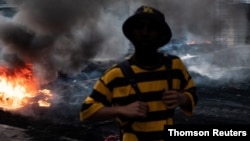Myanmar’s most violent day was “like a war,” according to frontline medical workers, as the military crackdown continued since the coup on Feb. 1.
Thousands of anti-coup protesters have been in the streets voicing their opposition to military control, while sector professionals are refusing to work under the junta government, officially the State Administrative Council. More than 2,000 demonstrators have been detained and hundreds have been killed, according to the Assistance Association Political Prisoners Burma (AAPPB).
Myanmar saw its bloodiest day to date on March 14, when anti-coup street protests in Yangon were met by a large-scale backlash from the military that opened fire, killing at least 74 people in the Hlaing Thayar Township alone, according to a report by the AAPPB.
One Burmese doctor working in the Hlaing Thayar Township recalled an incident outside his clinic as protesters were using makeshift shields to block a military onslaught.
“One of the front-line protesters was injured to the neck by a real bullet, which penetrated his shield and then to the neck. He collapsed in front of our clinic. He died of [a] gunshot injury to the neck, which is so severe by piercing the main artery,” the doctor told VOA.
A Burmese medical worker told VOA that dozens of injured patients and dead bodies frantically poured into her hospital in the Thingangyun Township in Yangon, as doctors and nurses who were participating in protests rushed back to treat the incoming patients.
“I can’t count, dead bodies are arriving. Some are dead on arrival. I have to do so many CPR procedures. They run to the hospital, and they were doing resuscitations. [It was a] bloody field that day,” the medical worker said.
Even though most patients had been injured from gunshots, the medical worker said, she was surprised it was a great deal more subdued than she expected.
“They were not shouting. It was very strange. Most of the patients are very young, about 20 to 25 years old. They are not afraid,” she told VOA.
Many protesters even wrote their phone numbers and blood types on their bodies before they went to protest, seemingly in preparation for any medical care they might need.
“Some are very brave. So many patients arrived at the same time. It’s like a war. Like in war times. I’ve never seen this before,” she noted.
The military also is targeting the Civil Disobedience Movement (CDM) participants, a protest campaign that has seen thousands of Myanmar professionals go on strike, including medical workers.
And the surgeon admits she’s concerned the military might target her hospital next. “I’m very worried. If they occupy, if they control my hospital, we cannot conduct an operation like this,” she said.
An emergency doctor at a Yangon hospital said real bullets were largely the cause for so many injured and killed protesters Sunday.
“On that day, I received at least 55 gunshot wound victims. Out of those 55, they used the real bullets for 50 patients,” the doctor said.
The doctor told VOA he witnessed the “8888 uprisings” in 1988, where thousands were killed. The doctor was also working during the Saffron Revolution in 2007. But from his experiences, the current military is targeting protesters to kill them.
“In the other uprisings, they shot at them not aiming at the head, neck or chest. Someone who was unlucky might have died on the spot or at the hospital. They were hit in the hands or the thigh, some maybe lethal, some maybe not lethal,” he said.
“But now, their attack is like a military battle. They probably use the sniper. Headshots are many. This is different. I found many dead patients, dead at the scene; they had just one shot,” the doctor said.
“They aim to kill, not to threaten,” he underscored.
The doctor said the military is even targeting medical employees in ambulances, who are attempting to retrieve injured patients from danger zones.
“This time, 2021 is very much more difficult than 2007 because the military is trying to shoot even through the ambulances. It’s very ugly. Shoot the ambulances or arrest the ambulance crew, or they do not allow the medical crew through to the scene,” he added.
Zeya Thu, a Myanmar political commentator, acknowledged the current uprising has reached the Myanmar people on a much larger scale than previously.
“People from all sorts of life are taking part in the 2021 movement against the coup, and the movement is a lot bigger than the one in 2007,” he told VOA.
The current crackdown by the military already has seen more deaths than the Saffron Revolution, Myanmar’s previous uprising in 2007, where thousands protested in the streets about fuel prices.
According to various reports, the death toll in 2007 ranged from at least 13 to upwards of 100, although VOA has obtained additional details from a leaked police report stating there were more than 20,000 arrests and 34 people killed during the 2007 unrest.
Myanmar, formerly known as Burma, gained independence from Britain in 1948, but most of its modern history has been governed under military rule.
The NLD party led by Aung San Suu Kyi won the country’s first open democratic election in 2015. But in last November’s general elections, the military contested poll results, claiming widespread electoral fraud, without evidence. On Feb. 1, the Myanmar military, also known as Tatmadaw, removed the NLD government. Leader Suu Kyi and President Win Myint were detained and have since been additionally charged.
Armored vehicles and live ammunition have been deployed by the military to suppress protests, while martial law has been imposed across the country. The junta has implemented daily internet shutdowns for the sake of the country’s stability, it said.




